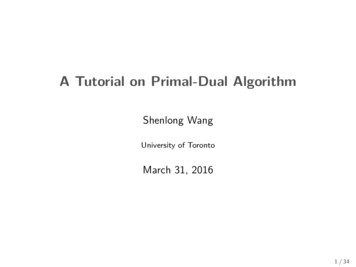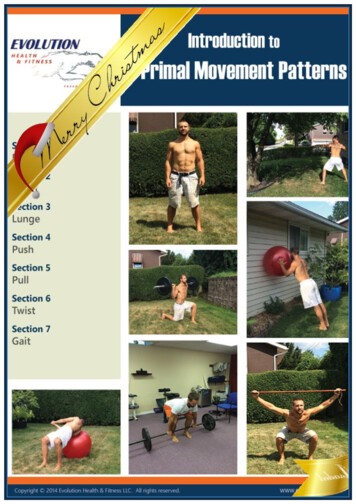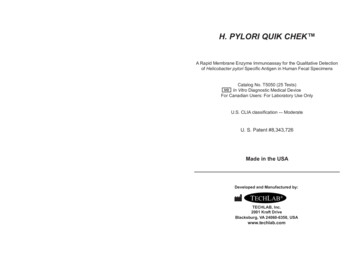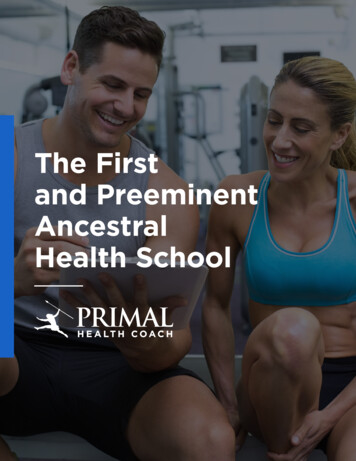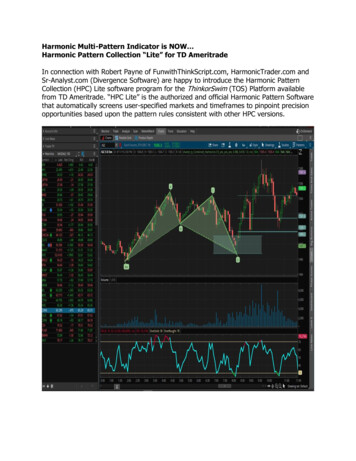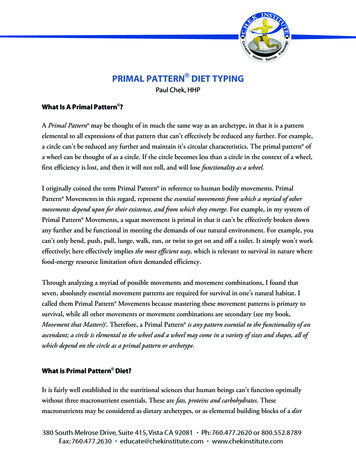
Transcription
PRIMAL PATTERN DIET TYPINGPaul Chek, HHPWhat Is A Primal Pattern ?A Primal Pattern may be thought of in much the same way as an archetype, in that it is a patternelemental to all expressions of that pattern that can’t effectively be reduced any further. For example,a circle can’t be reduced any further and maintain it’s circular characteristics. The primal pattern ofa wheel can be thought of as a circle. If the circle becomes less than a circle in the context of a wheel,first efficiency is lost, and then it will not roll, and will lose functionality as a wheel. I originally coined the term Primal Pattern in reference to human bodily movements. PrimalPattern Movements in this regard, represent the essential movements from which a myriad of othermovements depend upon for their existence, and from which they emerge. For example, in my system ofPrimal Pattern Movements, a squat movement is primal in that it can’t be effectively broken downany further and be functional in meeting the demands of our natural environment. For example, youcan’t only bend, push, pull, lunge, walk, run, or twist to get on and off a toilet. It simply won’t workeffectively; here effectively implies the most efficient way, which is relevant to survival in nature wherefood-energy resource limitation often demanded efficiency. Through analyzing a myriad of possible movements and movement combinations, I found thatseven, absolutely essential movement patterns are required for survival in one’s natural habitat. Icalled them Primal Pattern Movements because mastering these movement patterns is primary tosurvival, while all other movements or movement combinations are secondary (see my book,Movement that Matters)i. Therefore, a Primal Pattern is any pattern essential to the functionality of anascendant; a circle is elemental to the wheel and a wheel may come in a variety of sizes and shapes, all ofwhich depend on the circle as a primal pattern or archetype. What is Primal Pattern Diet?It is fairly well established in the nutritional sciences that human beings can’t function optimallywithout three macronutrient essentials. These are fats, proteins and carbohydrates. Thesemacronutrients may be considered as dietary archetypes, or as elemental building blocks of a diet
because neither alone can be considered a diet. To clarify this example, let’s look again at the basicsof movement and consider that just as every exercise has a beginning (start) phase, an executionphase, and an end phase or completion (without which, an exercise can’t exist as an exercise), a dietcan’t exist without fats, proteins and carbohydrates and be considered “a diet.” In this regard, we havemacronutrients that are essential components of a natural diet, yet when we change the ratio of fats,proteins and carbohydrates, we at once change their pattern, and therefore, we have changed the diet.Biologically speaking, human beings have spent potentially millions of years evolving on the planet,during which time survival generally depended upon the availability of macronutrients found intheir food. Yet, importantly, the pattern of their availability varied both geographically and seasonally.Current research confirms that our DNA adapt to any given environment over time (see the work ofBruce Liptonii). There are two aspects we look at when speaking about DNA: genotype and phenotype.The term genotype refers to the aspects of the gene that may be considered relatively hardwired, whilethe term phenotype refers to the degree of adaptability or range of expression within the DNA’shardwiring. For example, twins have the same genes (genotype), yet one of them may be morecomfortable on hot days than the other, while the other may be more capable of swimming in coldwater (phenotype). If we have genetic weaknesses, we have a range of environmental stress we canhandle before expressing the weakness. When we live comfortably within a safe range (calledhomeostasis) and meet our biological needs, stress is minimized and genetic weaknesses that mayresult as disease are suppressed.Each individual’s genes carry the entire chain of their ancestral influences or programming, whichemerged from environmental influences (the selective pressures of nature). Though we are all humanbeings with the same human genes (genotype), those of us with ancestors emergent in regions of theworld where the ground freezes will naturally need to consume more animal flesh to maintain ourenergy source and stay alive than those emergent from regions progressively closer to the equator, whowill have a larger variety of options due to the fact that plant and animal foods are more readilyavailable year round (phenotype); phenotypical expression can vary even among twins, not just fromregion to region. Those emergent from harsh desert regions often have less variety and must dependprimarily on plant based foods because of a scarcity of big game animals and animals with enough fatfor optimal human metabolism; the only exception being nomads.Early in the 20th century, Byron Robinsoniii M.D. tested this theory by dissecting cadavers fromregions of the world with significantly different environmental conditions, and therefore foodstuffs.
He discovered that the range of length among human entrons (digestive tubes measured mouth toanus) ranged from about 21 to 42 feet a remarkable difference. Those with the longest entronscame from regions with high plant food intake and those with the shortest entrons came fromregions where animal flesh was more prevalent in the diet. His research showed that though they allhad digestive systems, the selective pressures of nature changed the organism to favor adaptation asexpressed through the phenotype.Keeping this in mind then, a Primal Pattern Diet is a diet that expresses the pattern of fats, proteinsand carbohydrates unique to the dominant region of your racial and ethnic ancestry. Though all humanshave a genetic need for fats, proteins and carbohydrates in some combination, phenotype expressionwill vary due to selective pressures over time in any given environment. For example, Weston A.Priceiv showed very clearly in his book, Nutrition and Physical Degeneration, that macronutrient ratioscould range from the Eskimo eating about 90% animal foods: 10% plant foods to the inlandAboriginal eating the opposite ratio of about 90% plant foods: 10% animal foods, yet people livingin different regions with radically different food ratios were found to be very healthy world-wide!These people were eating according to their “Primal Pattern Diet!” They were effectively meeting theneeds of their genotype, and developed a phenotype that allowed them to adapt to the uniquecircumstances of their specific racial and geographical environment. What is Primal Pattern Diet Typing?Primal Pattern Diet Typing is a system for identifying your optimal starting point for fine-tuningyour macronutrient (animal to plant food) ratios. Today, this is not so easily done because in thepast 1,000 years there has been an increase in racial mixing as we’ve become progressively moremobile. Only a few hundred years ago, it was normal for an Aboriginal to live their entire lifewithout meeting an Eskimo or any other significantly different race (and therefore, genes). Today,the Eskimo thriving on about 90% animal foods: 10% plant foods could mate with the inlandAboriginal eating the opposite ratio of about 90% plant foods: 10% animal foods. Their offspringcould have a phenotype akin to the mothers, the fathers, or require a range of nutrients far broaderthan either parent alone! This can create some interesting dietary challenges because of the variancesin phenotypes among races with such radically different environmental demands on their genes.
Unfortunately, though we now live in racial melting pots where there are few pure races left,nutritionists and dietitians, worldwide, prescribe meal plans based on percentages of proteins, fatsand carbohydrates. Though there are thousands of diet books and millions of people following suchadvice, we are the most obese, unhealthy people ever, and childhood obesity in the United States isan epidemic! Did you know obesity is America’s costliest disease? Right now (in 2010), “1 in 3adults and 1 in 5 children struggle with obesity. Taxpayers, governments and businesses spendbillions on obesity-related conditions each year, including an estimated 147 billion in medicalcosts” (Campaign to End Obesity, 2010).vWhat is Wrong?In a nutshell, what is wrong is that we lack clear understanding of how to eat whole food and thisincludes an understanding of what protein, fat and carbohydrate ratios are! In most of our educationwe are taught very confusing information. Just look at what happened just a couple of decades agoduring the 1980’s when the “experts” (funded by corporations) told us to “eat lots of carbs.” Nowthat advice of the eighties is largely responsible for the sugar/fructose/starch carb addicted populationof today! Now they are promoting calorie counting. You see it promoted in fast food restaurants andit is even part of the Health Care Reform Bill that will affect thousands of restaurants and will behard for uneducated, ill-informed consumers to ignore.viIf you’ve understood what I’ve shared so far, you should be able to immediately grasp one key aspectof what has gone wrong with mainstream nutritional and medical thinking. Understandingprotein/fat/carbohydrate ratios are important from a biological perspective when we are discussingPrimal Pattern Diets. Carbohydrates are the most common source of energy in living organisms.Proteins and fat are necessary building components for body tissue and cells, and are also sources ofenergy for most organisms. Let’s look at another commonly overlooked aspect that is relevant toPrimal Pattern dieting and how the source of our food grown in healthy soil contributes to humanvitality or human disease. Protein and Fat RatiosMost people mistakenly think that a gram of meat is a gram of protein, including many so-callednutrition experts. This is far from the truth. Animal flesh at large is about 70% water, so how coulda gram of animal flesh equal a gram of protein? Numerous studies in agriculture have shown that
both the environment and farming methods can radically influence protein content in plant oranimal foods. Just look at organic pioneer Ehrenfried Pfeiffer’svii research into microbiology and soilhealth. He showed that conventionally grown wheat is typically about 12% protein, whilebiodynamically grown wheat was often 18% protein! That’s a huge difference when you considerthat a gram of chicken is only about 22% protein! Research by Lady Eve Balfourviii, Sir RobertMcCarrisonix, Sir Albert Howardx, and others showed that fertilization of soil could have asignificant influence on protein content in plants, which influence the animals and humans that eatthem.Today, we have a much higher ratio of saturated to unsaturated fatty acids in our diet due to a highconsumption of hydrogenated fats. As a matter of fact, most diets that westerner’s consume havetwice the amount of fat, a much higher ratio of saturated to unsaturated fatty acids. The sources offat and the kinds of fat we typically consume today are very different to those of our ancestors.Virtually all fats found in natural foods are basically mixtures of saturated, monounsaturated andpolyunsaturated 'fatty acids' in different proportions. Animal fat in itself is a normal food forhumans and has been for countless millennia. Fat ratios are essential when digesting proteins and aidin energy metabolism as well as the production and regulation of essential hormones. Studies ofNorth American Indians, Eskimos and other tribes living in cold regions of the world suggest that asmuch as 80% of their daily caloric intake was from fat, most of which was saturated animal fat!xiWhen consuming animal proteins it is important to eat the fat that naturally exists with the meat.Additionally, we must remember that the fat can only be as healthy as the animal, which is directlylimited by farming environment and foods fed to the animals. As I show in my program titled YouAre What You Eatxii, commercial farmers regularly feed animals such items as saw dust, engine oil,plastic chips, sewage, and dead animal parts. In order for the animals to survive, they must use lots ofantibiotics and drugs. All this ends up in the flesh, and the fat, of such animals!Carbohydrate RatiosCarbohydrates perform numerous roles in living things, primarily as a source of energy.Carbohydrate content and quality are also influenced by the environment and farming techniques.Researchers such as Carey Reamsxiii, Arden Andersenxiv, D.O., Philip Calahanxv, Ph.D., and othershave demonstrated this by using a Brix meter (a hand-held device with a prism at one end, and aneyepiece at the other acting as a refractometer). This measures the fraction of sugar per hundredparts of aqueous solution and can determine the overall nutrient composition of plants. The brix
measurement can be read off the scale, showing levels of sugar, minerals, proteins and vitamins inthe plant's juices, commonly referred to as dissolved solids. The higher the Brix reading, the higherthe nutrient levels. Again, these researches established through their investigations that soil rich innutrients changed the overall Brix reading and thus, not all sources of carbohydrates are createdequal.Identifying your optimal food ratio and making sound food choices is imperative if you want tominimize addiction, obesity and disease in favor of a quality life of vital health and happiness! Eatinga variety of natural foods for your type will insure healthy digestion and elimination.So Where Does That Leave The Diet Experts and Their Followers?Confused, unhealthy and overweight! The fact is, without comprehensive laboratory analysis, youcan’t possibly know the ratio of proteins, fats and carbohydrates in any foodstuff. It’s impossible! Inmy opinion, this is why virtually every diet method that bases its guidelines on percentageprescriptions is ultimately doomed to fail. That’s why I developed the Primal Pattern Diet Typingsolution. In my now 25-year career, I have studied the works of hundreds of nutrition, health and medicalexperts. Many of them identified elements of what is simple, yet complex - the human diet! Like me,they each began with educational influences and a practice that soon hit limitations, and had tobegin looking outside their own paradigm in order to progress their own offering. Many worked inthe area of micronutrients, looking at isolates such as vitamins, minerals, enzymes and co-factors.Though some of them made useful discoveries and advancements, their approach was typicallymicroscopic!I found the works of Rudolph Steinerxvi, Ehrenfried Pfeiffer, Lady Eve Balfour, Sir Albert Howard,Friend Sykesxvii, Sir Robert McCarrison, William A. Albrechtxviii, Weston A. Price, Francis MarionPottengerxix, M.D., Byron Robinson, M.D., and William Wolcottxx (and many others) to offer amuch more realistic, practical approach to healthy eating.
These pioneering researchers all showed that soil quality, farming methodology, environment, racialand ethnic needs, stress, and stress interpretation could radically influence the health of the plants,animals and those that eat them. They also produced evidence that each given race or culture’sdietary needs vary radically depending on environment, which dictates availability.How Does Primal Pattern Diet Typing System Work?Using a questionnaire system inspired by William Wolcott, Bill Timminsxxi, N.D., Jeffery Blandxxii,Ph.D., and others with similar systems, I created my own questionnaire system. My goal is to helpyou find the starting point for identifying your Primal Pattern Diet Type, which is the way youshould naturally eat. In my book How To Eat, Move and Be Healthy!xxiii, I share several key ways tofine-tune your macronutrient ratio from meal to meal. Because there is no objective way to identifyfat, protein and carbohydrate ratios on your own, the key to my Primal Pattern Diet System is tolearn to pay very close attention to the fine tuning methods shared in my book and to listen verycarefully to my audio series You Are What You Eat! Both of these resources teach you what you needto know about food so that you can effectively find and eat quality foods and not suffer from thelegal trickery used by food manufacturers! When you use my Primal Pattern Diet Typing questionnaire system (click link at bottom of article)to find your starting ratio, you’ve just begun. I identify your approximate macronutrient ratio, whichcategorizes you as one of the following Primal Pattern Diet Types: Polar TypeThe polar types come from regions closer to the North or South poles of the earth. These people hadhigher requirements for animal flesh (as fat and protein sources) because the ground freezes andplants don’t grow in ice! These people may be exemplified by your Eskimos, Icelandic, Nordic,Scandinavian, English, Scottish, or Irish peoples, to name a few. Polar types are the equivalent to aprotein type in most of the traditionally known systems of metabolic typing used today (Kellyxxiv,Kristalxxv, Wolcott, Ingramxxvi, etc.). The Polar Types generally begin their self-assessment by creatinga meal plan that provides two servings of flesh foods for every serving of plant foods or produce.
Equatorial TypeThe people who live in the warmer regions of the world where the ground is unlikely to freeze in thewinter are called Equatorial types. Because of the hotter weather, they have access to fruits andvegetables year round, making them less dependent upon animal flesh than the Polar Types. TheEquatorial types include desert peoples such as the inland Aboriginals, Quechua Indians and othersthat have very little access to animal flesh and have to live primarily off of plant foods, rodents andinsects. The Equatorial Type is akin to the carbohydrate types common to other metabolic typingsystems. Equatorial Types should begin the process of individualizing their meal plans by eating equalservings of plant and animal foods.Variable TypeThese people exemplify those that are likely to come from mixed race families and often have a widerange of nutrient needs. I feel I may be one of these. My father’s bloodlines are Cherokee Indian,while my mother’s bloodlines come from the region called Alsace Lorraine, a little region of Francenear Germany. The result is that I can be a Polar Type at breakfast and range all the way to anEquatorial Type with any other meal depending on external environmental factors, such as weather,and internal environmental factors, such as stress.My friends, this is your Primal Pattern Diet Typing System in a nutshell. Having coachedthousands of people to optimal health and well being, I can assure you that this system is simple, butis more effective than most systems out there. One of the reasons it works so well is because onceyou learn how to eat using these guidelines, your dietary needs are fully customized from meal tomeal. How to Fine Tune Your Diet for Optimal Physical Emotional, Mental and Spiritual Wellbeing!If you would like to learn more about how to apply my simple and highly effective systems of diet,lifestyle and exercise, see my book How To Eat, Move and Be Healthy! I have included a section onfine-tuning your eating plan that you should study because my material is loaded with other essentialinformation you all need to be aware of. For those of you that would like to learn my most up-todate fine tuning technology, which serves as an addition to the essential information in my book andmy audio/workbook, You Are What You Eat!, please see my multi-media e-Book: The Last 4 Doctors
You’ll Ever Need, How To Get Healthy Now!xxvii, as well as listen to my MP3 audio companionsxxviii ofthe same title.iChek, P. (2001). Movement that Matters. C.H.E.K Institute, San Diego, CA.iiLipton, B. (2008). The Biology of Belief: Unleashing The Power of Consciousness,Matter and Miracles. Hay House.iiiRobinson, B. (1907). The Abdominal and Pelvic Brain. Available on/Rob1cont.htmivPrice, W. A. (2008). Nutrition and Physical Degeneration, 8th Ed. Price PottengerNutrition.vThe Campaign to End Obesity. Obtained from http://www.obesitycampaign.org/viSource: Calorie Counting Part of Health Care Reform Bill NBC San DiegoviiDiver, S. Nutritional Quality of Organically Grown Food. Available lviiiBalfour, E. (2006). The Living Soil. Soil Association Ltd.ixMcCarrison, R. (1921). Studies in Deficiency Disease. Cornell University Library.xHarrison, A. (2007). The Soil and Health: A story of Organic Agriculture. TheUniversity Press of Kentucky.xiGetoff, D. (2001). Attaining Optimal Health in The 21st Century, Audio Series.xiiChek, P. (2003). You Are What You Eat! Audio-workbook. C.H.E.K Institute, SanDiego, CA.xiiiReams, C. A. (1997). Choose Life or Death: The Reams Biological Theory ofIonization. Holistic Laboratories, Inc.xivAndersen, A. B. (1989). The Anatomy of Life and Energy in Agriculture. Acres USA.xvCalahan, P. (2001). Tuning Into Nature. Acres USA.xviSteiner, R. (2007). Agriculture Course: The Birth of the Biodynamic Method. RudolphSteiner Press.
xviiSykes, F. (1959). Modern Humus Farming. Rodale Press.xviiiAlbrecht, W. A. (2005). Soil Fertility and Animal Health, 2nd Ed. Acres USA.xixPottenger, F. M. (1995). Pottenger’s Cats: A Study in Nutrition, 2nd Ed. Price PottengerNutrition.xxWolcott, W. L. (2002). The Metabolic Typing Diet: Customize Your Diet to Your UniqueBody Chemistry. Broadway.xxiSource: http://www.biodia.com/xxiiSource: http://www.jeffreybland.com/xxiiiChek, P. (2004/2009). How To Eat Move and Be Healthy! C.H.E.K Institute, SanDiego, CA.xxivKelley, W. (1999). Dr. Kelley's Self Test for the Different Metabolic Types. College ofMetabolic Medicine.xxvKristal, H. J. (2002). The Nutrition Solution: A Guide to Your Metabolic Type. NorthAtlantic Books.xxviIngram, C. (2008). Eat Right 4 your Metabolic Type. Knowledge House.xxviiChek, P. (2005). The Last 4 Doctors You’ll Ever Need: How To Get Healthy Now! Multi-media e-Book.Available from /showProductDetail?productId 102xxviiiChek, P. (2008). The Last 4 Doctors Audio Companions. MP3 download. Available ront/showProductDetail?productId 82
Primal Pattern Movementsin this regard, represent the essential movements from which a myriad of other movements depend upon for their existence, and from which they emerge. For example, in my system of Primal Pattern Movements, a squat movement is primal in that it can't be effectively broken down


